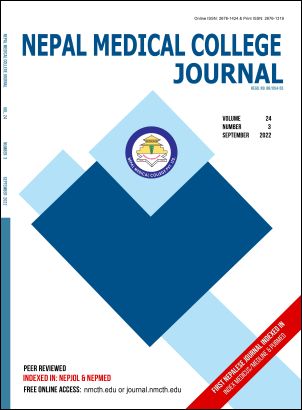Determinants of immediate adverse pregnancy outcomes: A hospital based study
DOI:
https://doi.org/10.3126/nmcj.v24i3.48599Keywords:
Antenatal visit, postpartum, hemorrhage, low birth weight, preterm delivery, blood transfusion, neonatal jaundiceAbstract
Adverse pregnancy outcomes are a major public health problem which can lead to serious short and long- term health effect to the mother and the newborn. Hence, the objective of this study is to find out the determinants of immediate adverse pregnancy outcomes in tertiary care hospital in South India. The study comprised of antenatal mothers admitted for delivery in selected tertiary care hospital in Belgaum, Karnataka, India from 10th November, 2021 to 20th January 2022. All registered deliveries in the study period have been included, comprises of 101. Bivariate logistic regression was used to determine the factors associated with outcome variables. A significance level of 5% was used to decide the significance of statistical tests. The mean age in years (± SD) of the mother was 24.6 (± 3.9). The average cost invested for a family health check-up in a year was Rupees 18,099. The average birth weight of the newborn was 2.7 kg, while the minimum weight of the newborn was 1.4 kg, and the maximum weight was 3.8 kg. The average week of gestation for the first-time with respect to antenatal care visit of pregnant women was 9.6 weeks. The average weight of the women was 47.6 kg during first antenatal care visit and 61.5 kg during last antenatal care visit. Adverse outcomes reported were post-partum hemorrhage was 7.9%, low birth weight 26.7%, preterm delivery 28.7%, anemia 53.5%, neonatal physiological and jaundice 15.8%. However, use of mode of transportation during antenatal care visit was found to be significant factor for preterm delivery. Every fourth baby was low birth weight, and every fourth women have preterm delivery and every second woman was anemic. Socioeconomic, demographic and chronic illness was associated with immediate adverse pregnancy outcomes.
Downloads
Downloads
Published
How to Cite
Issue
Section
License
Copyright (c) 2022 Nepal Medical College Journal

This work is licensed under a Creative Commons Attribution 4.0 International License.
This license enables reusers to distribute, remix, adapt, and build upon the material in any medium or format, so long as attribution is given to the creator. The license allows for commercial use.




